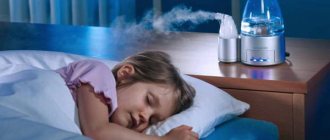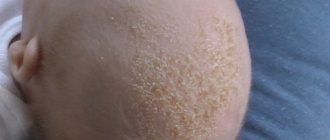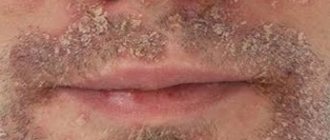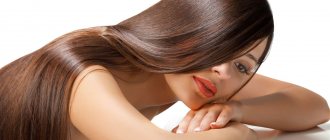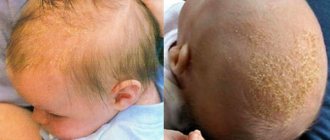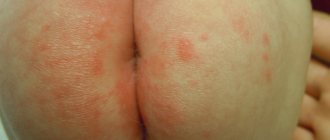How does seborrheic dermatitis manifest in adolescents?
Foci of inflammation appear primarily on the face: on the nose, forehead, around the eyes, as well as on the chest and between the shoulder blades, on the scalp. In all these areas there are a large number of sebaceous glands, and it is because of disturbances in their work that seborrhea develops. The causative agent of seborrheic dermatitis is considered to be a fungus from the Malassezia family, which feeds on fatty acids that are part of the secretions from the sebaceous glands. It is part of the natural human microflora. When the body works normally, the amount of fungus does not threaten health. But when the balance is disrupted, the functioning of the sebaceous glands changes, and the fungus begins to actively develop and cause harm.
Types of seborrhea in adolescents:
- oily: with increased sebum secretion, acne appears, skin and hair become greasy;
- dry: sebum production decreases, pores narrow, which also causes acne, comedones, and dandruff to appear on the head.
In some cases, seborrheic dermatitis is mixed.
Symptoms of seborrheic dermatitis:
- skin irritation accompanied by itching, swelling, redness;
- peeling, which can be very intense;
- acne in large quantities;
- painful sensations on the skin, especially when touched.
In the absence of proper care and treatment, skin scales constantly flake off, and the skin underneath becomes red and wet. If you scratch the inflamed areas, it causes pain, leads to scratches and microtraumas, through which secondary infection occurs.
On the scalp, flaking leads to dandruff.
Forms of seborrhea
Taking into account the external manifestations of the disease and the specificity of the disorders, three forms of seborrhea of the scalp are distinguished:
- fat;
- dry;
- mixed.
Oily seborrheic dermatitis is observed with excessive production of fatty secretions and is characterized by high oiliness of the dermis and hair, yellowish or red spots on the skin, profuse oily dandruff, thinning and hair loss. Moderate manifestations of the fatty form of the disease are quite common in adolescents and, with proper care, after normalization of hormone levels, do not require special therapeutic effects.
With dry seborrhea, the fatty secretion is produced in insufficient quantities, resulting in a feeling of skin tightness, dryness, severe itching and burning, and dandruff in the form of small dry scales. The hair becomes very thin, becomes dull, brittle and begins to fall out profusely.
The most problematic in terms of treatment is the mixed form of seborrheic dermatitis, in which fatty secretion is secreted in excess in some areas of the dermis, and in deficiency in others.
What happens if seborrhea in teenagers is not treated?
Often, when skin problems appear during puberty, parents think that they will go away on their own with time. Yes, sometimes that happens. But often teenage seborrhea becomes chronic, from which a person suffers throughout his life.
The consequences of seborrheic dermatitis can be eczematous conditions and severe forms of acne. If seborrheic manifestations are localized on the head, this leads over time to hair loss and even baldness. If the dermatitis affects the area around the ears, it can spread inward and lead to ear infections.
Differential diagnosis of diabetes and other dermatological diseases
Diagnosis of seborrheic dermatitis is based on the clinical picture and includes assessment of the nature of the rash (color, shape, and other properties), its location and symmetry. Sometimes it is necessary to use microbiological diagnostics if there is a suspicion of an initially infectious nature of the rash or the addition of a secondary bacterial/fungal infection.
The difficulty in diagnosing seborrheic dermatitis lies in making a correct differential diagnosis with other clinically similar dermatological diseases, because psoriasis, atopic dermatitis, lichen planus, and rosacea (rosacea).
Causes of seborrheic dermatitis in adolescents
As mentioned above, the causative agent of dermatitis is a fungus. However, it does not begin to multiply and function too actively without any reason. It becomes overly active only when the balance in the body is disturbed, the reasons for which are the following factors:
- puberty;
- heredity, genetic predisposition;
- disturbances in the functioning of the gonads, adrenal glands, pituitary gland, thyroid gland;
- disruption of the endocrine system, which disrupts the production of sebum;
- severe nervous tension, stressful situations;
- poor nutrition, lack of vitamins, as well as disturbances in the gastrointestinal tract;
- incorrect mode: lack of sleep, lack of walks and physical activity, sedentary lifestyle.
Only a doctor can determine the exact cause of dermatitis, especially if it lies in disturbances in the functioning of internal organs or systems. The doctor will order tests and examinations, make a diagnosis and prescribe treatment. But before visiting a doctor, you can analyze your health status, evaluate your lifestyle and guess the main reason. Often, normalizing your lifestyle allows you, if not to get rid of seborrheic dermatitis, then at least to slightly improve the condition of the skin.
Treatment of seborrheic dermatitis in adolescents
If the cause of seborrhea in a teenager is diseases of internal organs, disruptions in the functioning of body systems, then it is necessary to treat or at least stabilize them. Otherwise, the fight against seborrhea will be ineffective.
If there are no serious health problems, to treat seborrhea you need to carefully care for your skin and use specialized products for this.
Since the main cause of seborrheic dermatitis is an increase in yeast, it is necessary to combat it. For this you need antifungal drugs. These are medicated shampoos and gels, creams. They may have different active substances, for example, ketoconazole or sodium sulfide. The main thing is that they reduce the activity of the fungus and reduce its quantity. Such drugs are applied topically, that is, directly to the skin affected by the fungus. The frequency of application is in accordance with the instructions, but usually it is 1-3 times a week during the entire period of therapy, and after improvement of the condition - once a week to maintain the effect and prevention. Creams and gels are applied for absorption and do not wash off. And shampoos are applied and left for at least 5 minutes so that they have time to be absorbed into the skin and hair, and only then washed off.
There are entire lines of skin care products for seborrheic dermatitis on sale. For example, preparations from the Sulsen series contain selenium disulfide, which suppresses the activity of the fungus Pityrosporum Ovale and restores the balance of the scalp. The series includes shampoo, peeling, paste, cream, oil. You can choose hair care products for both boys and girls. They can be used from the age of 14 and are suitable for teenagers. They have a natural composition and do not cause allergies. The products are used twice a week. Typically, seborrheic symptoms disappear within a month, but you can use these drugs longer - until the effect is achieved, and then once every 1 - 2 weeks for prevention.
How to remove crusts on a child's head?
Thick crusts can be difficult to remove, try the recommended procedures:
- Once a day, when you bathe your baby, wash his hair with mild baby shampoo. Ask your pediatrician to recommend a shampoo for scalp crusts.
- Gently comb out the flakes with a comb or soft scalp brush and then rinse off the loose flakes with water. Do not rub or scratch your skin.
- You can also use baby oil or vegetable oil. Before combing out the scales, lubricate the child's head with oil; it will moisturize the skin and help loosen the scales on the head, making them easier to remove. After the procedure, wash the baby's head with shampoo.
Drug therapy
If cosmetics do not bring the desired effect, which happens quite rarely, then you need to contact a dermatologist who, after an examination, may prescribe drug therapy, for example, ointments containing glucocorticosteroids. There are also preparations for oral administration. They are released strictly as prescribed and prescribed by a doctor. These are serious drugs that have many side effects when used for a long time. For a teenager whose body is undergoing restructuring, this can have unpleasant consequences, so such methods should be resorted to only in extreme cases. You cannot use such products for more than a month.
Folk remedies
To alleviate the patient’s condition, you can use improvised means, for example, shampoos or ointments containing natural tar. They do not treat seborrheic dermatitis, but suppress excessive proliferation of the stratum corneum of the epidermis.
Tea tree oil has an antifungal and soothing effect. It is applied pointwise to inflamed seborrheic areas of the skin.
Any folk remedies do not treat seborrhea. Herbal infusions, decoctions, and lotions may cause short-term minor improvement in some adolescents, but for most they have no effect. They need to be used constantly, for a long time. And many natural remedies cause allergies, so the skin condition only worsens. They can be used as auxiliary, but not as the basis of treatment. If you rely on traditional medicine and natural remedies, you can waste time, so the recovery will be longer than when you immediately start using special remedies.
What else is needed for treatment
Most often, seborrheic dermatitis in children is associated with puberty. This condition is temporary. While seborrheic peeling and irritation persist on the skin, it is important to choose skincare products and lead a correct lifestyle:
- do not be nervous;
- Healthy food;
- take vitamin and mineral complexes;
- spend more time in the fresh air;
- get enough sleep.
If you have seborrheic rashes on your face, you should never cover them up with foundation. The skin must breathe, it is important to clean it promptly and regularly. Otherwise, the recovery process will take longer. Do not overuse visits to the bathhouse, sauna, or solarium.
If you follow these simple recommendations, seborrheic dermatitis will be less painful, and the skin disease will go away without a trace.
Features of the treatment of seborrhea of the scalp in children
One of the important factors determining the treatment methods for seborrhea in children is the age of the child. If in infants a slight manifestation of the disease is eliminated exclusively by supportive therapy - regular cleansing of the skin with special means and application of creams, then for the treatment of older children more drastic measures may be required.
In any case, before starting treatment for seborrhea in a child, you need to consult a specialist - a pediatrician, dermatologist or trichologist. Only a doctor can draw up an effective course of therapy that meets all the individual characteristics of the child’s body.
In general, seborrhea in children is treated in the same way as in adults - drug therapy is supplemented by the use of care products, diet and physiotherapeutic procedures. This comprehensive approach allows you to get rid of the disease in a relatively short time and avoid possible complications.
